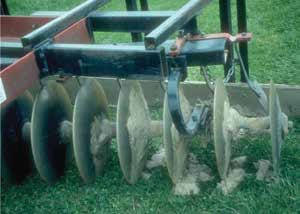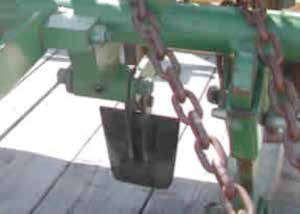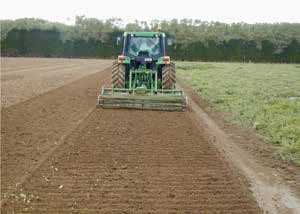chAPter 16 reduCing tillage
to loosen the soil and incorporate materials at the sur-
lighter one that performs shallower tillage and leaves
face (fertilizers, amendments, weeds, etc.), followed by
residue on the surface. Disks also create concerns with
one or more secondary passes to create a suitable seed-
developing tillage pans at their bottoms. They are some-
bed. Primary tillage tools are generally moldboard plows
times used as both primary and secondary tillage tools
(see figure 16.3, left), chisels (figure 16.3, right), and
through repeated passes that increasingly pulverize the
heavy disks (figure 16.4, left), while secondary tillage is
soil. This limits the upfront investment in tillage tools
accomplished with finishing disks (figure 16.4, right), tine
but is not sustainable in the long run.
or tooth harrows, rollers, packers, drags, etc. These tillage
Although full-field tillage systems have their disad-
systems create a uniform and often finely aggregated
vantages, they can help overcome certain problems, such
seedbed over the entire surface of the field. Such systems
as compaction and high weed pressures. Organic farmers
appear to perform well because they create near ideal
often use moldboard plowing as a necessity to provide
conditions for seed germination and crop establishment.
adequate weed control and facilitate nitrogen release
But moldboard plowing is also energy intensive,
from incorporated legumes. Livestock-based farms often
leaves very little residue on the surface, and often requires
use a plow to incorporate manure and to help make rota-
multiple secondary tillage passes. It tends to create dense
tion transitions from sod crops to row crops.
pans below the depth of plowing (typically 6 to 8 inches
Besides incorporating surface residue, full-field tillage
deep). However, moldboard plowing has traditionally
systems with intensive secondary tillage crush the natural
been a reliable practice and almost always results in
soil aggregates. The pulverized soil does not take heavy
reasonable crop growth. Chisel implements generally pro-
rainfall well. The lack of surface residue causes sealing
vide results similar to those of the moldboard plow but
at the surface, which generates runoff and erosion and
require less energy and leave significantly more residue
creates hard crusts after drying. Intensively tilled soil
on the surface. Chisels also allow for more flexibility in
will also settle after moderate to heavy rainfall and may
the depth of tillage, generally from 5 to 12 inches, with
“hardset” upon drying, thereby restricting root growth.
some tools specifically designed to go deeper.
Full-field tillage systems can be improved by using
Disk plows come in a heavy version, as a primary
tools, such as chisels (figure 16.3, right), that leave some
tillage tool that usually goes 6 to 8 inches deep, or a
residue on the surface. Reducing secondary tillage also
Figure 16.3. Left: Moldboard plowing inverts a sod and leaves no surface protection. Right: Chisel plow shanks till soil and leave some residue cover.
177
Building SoilS for Better CropS: SuStainaBle Soil ManageMent











